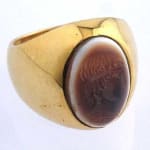Roman Banded Agate Intaglio Depicting a Bust, 100 CE - 300 CE
Agate/Gold
FJ.5481
The art of glyptic, carving on colored semiprecious stones, is possibly one of the oldest art forms known to man. Intaglios, gems with an incised design, were made as early...
The art of glyptic, carving on colored semiprecious stones, is possibly one of the oldest art forms known to man. Intaglios, gems with an incised design, were made as early as the fourth and third millennia B.C. in Mesopotamia and the Aegean islands, their virtuosity of execution suggesting an old tradition rooted in the earlier centuries. However, the gems from ancient Greece and Rome are worthy of special interest for it was then and there that the expressive and aesthetic language of glyptic was truly born. It was also during this period that portrait gems emerged. This intaglio, depicting the bust of an emperor, evidences this classic tradition of skilled carving, and the portrayal of an emotional spirit that is indeed exceptional. How fortunate we are that this extraordinary artistic tradition can be experienced today through this magnificent work of glyptic art.



